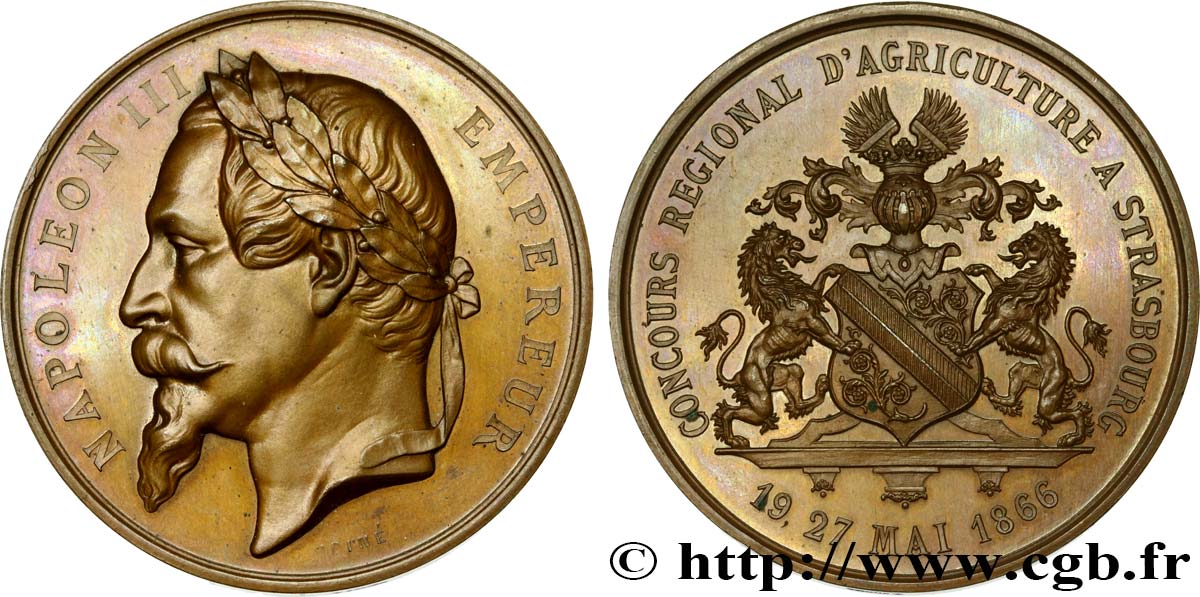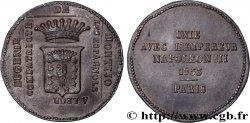fme_479120 - SECOND EMPIRE Médaille de concours agricole
无库存.
所有在网站上销售的产品 (2018)
价格 : 200.00 €
所有在网站上销售的产品 (2018)
价格 : 200.00 €
种类 Médaille de concours agricole
日期: 1866
铸币厂名称/城市 67 - Strasbourg
材质 copper
直径 50,5 mm
模子方针 12 h.
硬币制模工 OUDINÉ Eugène-André (1810-1887)
重量 60 g.
侧面 lisse + abeille CUIVRE
印模 Abeille (1860 - 1880) CUIVRE
关于品相的说明
Bel exemplaire présentant quelques traces de manipulation dans les champs. Superbe blason de ville au revers. Faible usure
正面
正面的文字 NAPOLÉON III - EMPEREUR.
正面的说明书 Tête laurée de Napoléon III à gauche; signé : OUDINÉ.
背面
背面的文字 CONCOURS RÉGIONAL D’AGRICULTURE A STRASBOURG - 19, 27 MAI 1866.
背面的说明书 Blason de la ville de Strasbourg.
评论
On remarquera la finesse des détails du blason de la ville de Strasbourg. Celui-ci est d’argent champ diapré à la bande de gueules. Il est le négatif des antiques armes de l'Evêché de Strasbourg.
Pour la petite histoire du blason, ses couleurs furent inversées par les bourgeois strasbourgeois suite à l'insurrection en 1262 contre la tutelle de l'évêque.
Un site internet parle de l’histoire de ce blason : http://svowebmaster.free.fr/drapeaux_Strasbourg.htm
Notons qu’il existe une variante en argent.
L’exemplaire est signé OUDINE sous le portrait. Eugène-André Oudiné, né à Paris le 1er janvier 1810, mort à Paris le 12 avril 1887, est un sculpteur, graveur et médailleur français. Il a été l'élève d’André Galle (1761 - 1844), de Louis Petitot (1794 - 1862) et de Jean-Auguste-Dominique Ingres (1780 - 1867). Il reçoit le premier grand prix de Rome de gravure en médailles en 1831. Il est l'auteur de plusieurs monnaies dont la pièce de 5 francs 1849 et 1850 en argent à la tête de Cérès de la Seconde République qui remplace l'écu au type Dupré de 1848. De 1837 à 1887 il fut le graveur officiel du Ministère des Finances. Il a également dessiné et gravé les timbres-télégraphe ainsi que les timbres pour journaux émis en 1868. Ses créations concernent également les timbres fiscaux : " Aigle de face " des timbres de dimension, " Aigle de trois-quart " des articles d'argent et des récépissés de chemins de fer, type " Chiffres " des timbres d'affiches, de connaissements, de copies, de quittances et type " Groupe allégorique " qui va servir pour les timbres fiscaux d'effets de commerce entre 1874 et 1885.
Pour la petite histoire du blason, ses couleurs furent inversées par les bourgeois strasbourgeois suite à l'insurrection en 1262 contre la tutelle de l'évêque.
Un site internet parle de l’histoire de ce blason : http://svowebmaster.free.fr/drapeaux_Strasbourg.htm
Notons qu’il existe une variante en argent.
L’exemplaire est signé OUDINE sous le portrait. Eugène-André Oudiné, né à Paris le 1er janvier 1810, mort à Paris le 12 avril 1887, est un sculpteur, graveur et médailleur français. Il a été l'élève d’André Galle (1761 - 1844), de Louis Petitot (1794 - 1862) et de Jean-Auguste-Dominique Ingres (1780 - 1867). Il reçoit le premier grand prix de Rome de gravure en médailles en 1831. Il est l'auteur de plusieurs monnaies dont la pièce de 5 francs 1849 et 1850 en argent à la tête de Cérès de la Seconde République qui remplace l'écu au type Dupré de 1848. De 1837 à 1887 il fut le graveur officiel du Ministère des Finances. Il a également dessiné et gravé les timbres-télégraphe ainsi que les timbres pour journaux émis en 1868. Ses créations concernent également les timbres fiscaux : " Aigle de face " des timbres de dimension, " Aigle de trois-quart " des articles d'argent et des récépissés de chemins de fer, type " Chiffres " des timbres d'affiches, de connaissements, de copies, de quittances et type " Groupe allégorique " qui va servir pour les timbres fiscaux d'effets de commerce entre 1874 et 1885.








 对产品描述纠错
对产品描述纠错 打印
打印 分享我的选择
分享我的选择 提问
提问 Consign / sell
Consign / sell
 产品介绍
产品介绍









